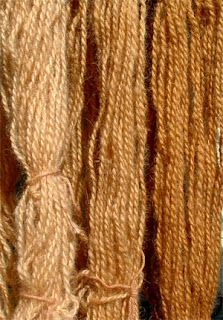 Before I get to the latest modifier I tried with the Cutch dye, here is a picture (on the left) of the very simple skein drying rack I have. It is simply a left over length of PVC pipe that is hung using rope tied to the canopy at either end. I simply slide the skeins on. Today was the first day we have had early morning sun and I discovered that the skeins are in full sun for about 30 minutes. Of course, this is low, early morning sun but still. After taking the pictures I slid them into the shade.
Before I get to the latest modifier I tried with the Cutch dye, here is a picture (on the left) of the very simple skein drying rack I have. It is simply a left over length of PVC pipe that is hung using rope tied to the canopy at either end. I simply slide the skeins on. Today was the first day we have had early morning sun and I discovered that the skeins are in full sun for about 30 minutes. Of course, this is low, early morning sun but still. After taking the pictures I slid them into the shade.
The next picture on the right is a closer picture of the medium and light DOS* and the three skeins that were modified with a soda ash rinse. I will post a picture later on of the dark, medium, and light DOS skeins from this batch. The first batch of Cutch I used hydrogen peroxide as an additive to darken the colors. I rather liked the effect. The book did not say how much to use, just 2% hydrogen peroxide added to the last 15 minutes. I thought the standard household hydrogen peroxide was 2% but it is actually 3%. When I calculated 2% hydrogen peroxide based on WOF* I got about 2 drops to add. That didn't make sense to me so I added 100 ml. I could see the dyebath change when I added it. I have a feeling that less would have been just as well. That would be something to test in the future as I do like the colors I got. The current batch is without the hydrogen peroxide added and I changed the DOS percentages. The first batch I used 4%, 6%, and 12% for light, medium, and dark DOS. I didn't think it was enough of a difference in the final result so with the second batch I used 2%, 6%, and 18% for light, medium, and dark DOS. I like the results.
 The picture on the left here is a close-up of the soda ash modified skeins. Now soda ash is generally used with cellulose fibers, not protein fibers*. Soda ash is alkaline and caustic. If too much is used with protein fibers, it will dissolve them. The book mentioned that a soda ash rinse reddens Cutch. I used 2% WOF for the amount of soda ash and proceeded as for an iron after-bath. That is I heated water, added the dissolved soda ash, and then swished the skeins in the bath until I saw the color change. Actually what I saw was the soda ash reddening the Cutch but also stripping the dye from the skeins! The skeins had been washed and rinsed until the water ran clear before I put them in the bath. The color did not redden and the skeins are slightly paler than the originals. I may have done something wrong or it may just not be appropriate for protein fibers. I will have to consult my mentor. Dana any ideas? I will say that I rinsed the skeins after the soda ash bath and I was concerned about the soda ash affecting the wool yarn so I added a quick splash of vinegar to neutralize. That may have done something too. So intriguing!
The picture on the left here is a close-up of the soda ash modified skeins. Now soda ash is generally used with cellulose fibers, not protein fibers*. Soda ash is alkaline and caustic. If too much is used with protein fibers, it will dissolve them. The book mentioned that a soda ash rinse reddens Cutch. I used 2% WOF for the amount of soda ash and proceeded as for an iron after-bath. That is I heated water, added the dissolved soda ash, and then swished the skeins in the bath until I saw the color change. Actually what I saw was the soda ash reddening the Cutch but also stripping the dye from the skeins! The skeins had been washed and rinsed until the water ran clear before I put them in the bath. The color did not redden and the skeins are slightly paler than the originals. I may have done something wrong or it may just not be appropriate for protein fibers. I will have to consult my mentor. Dana any ideas? I will say that I rinsed the skeins after the soda ash bath and I was concerned about the soda ash affecting the wool yarn so I added a quick splash of vinegar to neutralize. That may have done something too. So intriguing!I have a Pomegranate dyebath going at the moment. It is another dull color but tomorrow I will be dyeing with Cochineal bugs! I have been looking forward to it. Lush color too! I will post pictures of the final results of the Cutch dyeing tomorrow, and the Pomegranate as soon as it is done.
No question for today. -Renee
* please see glossary















